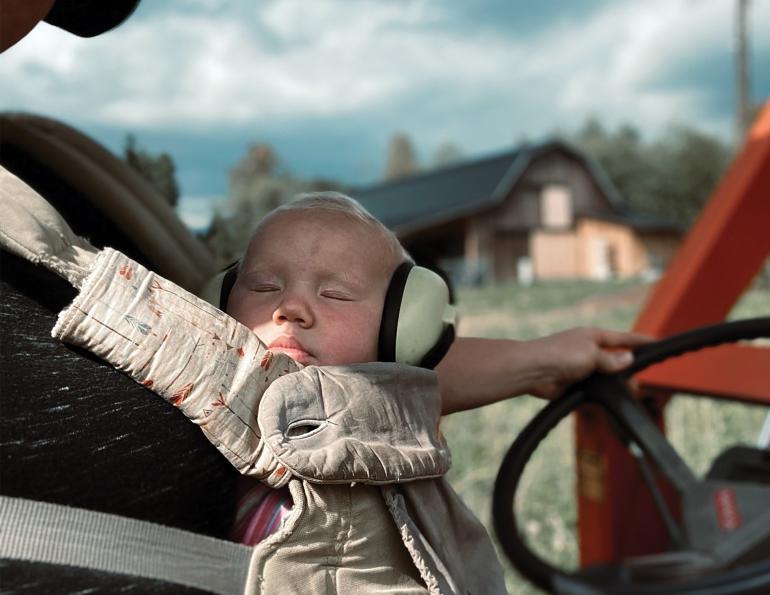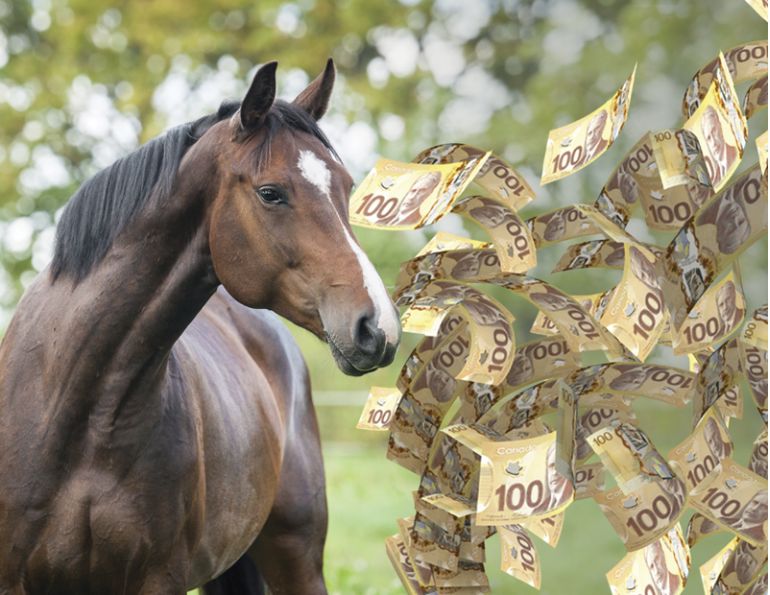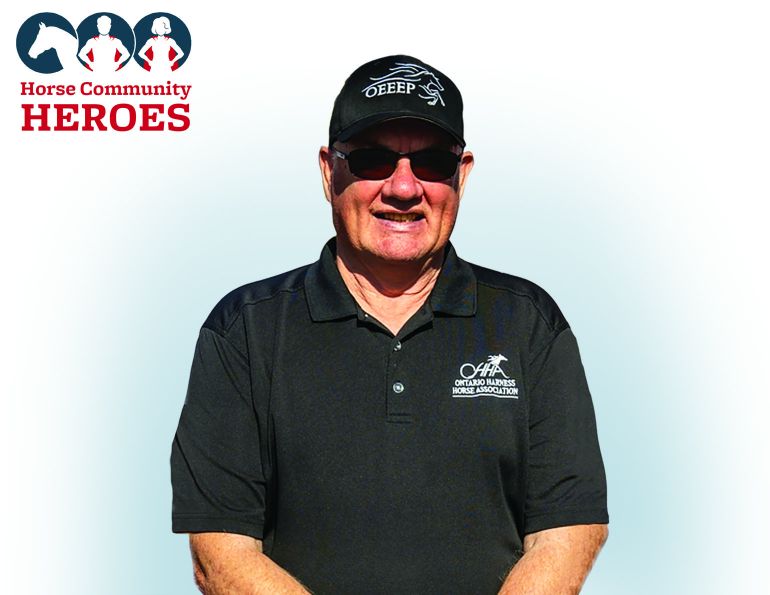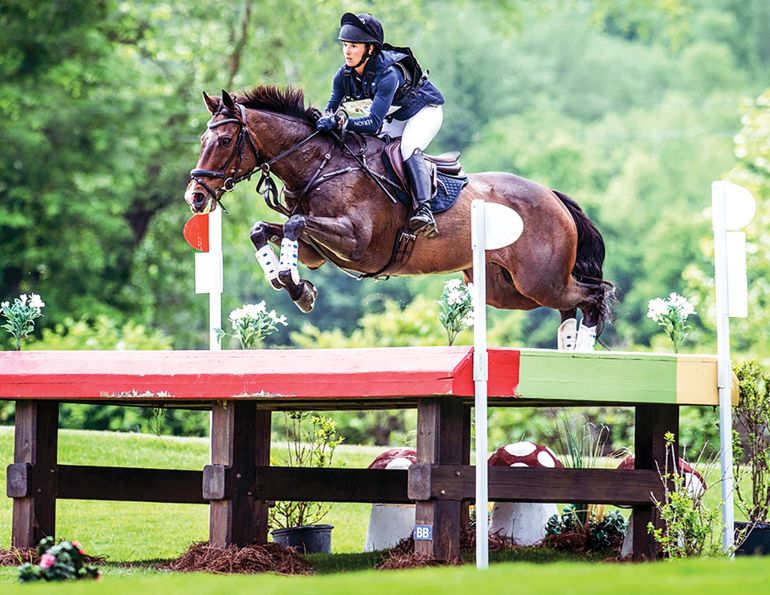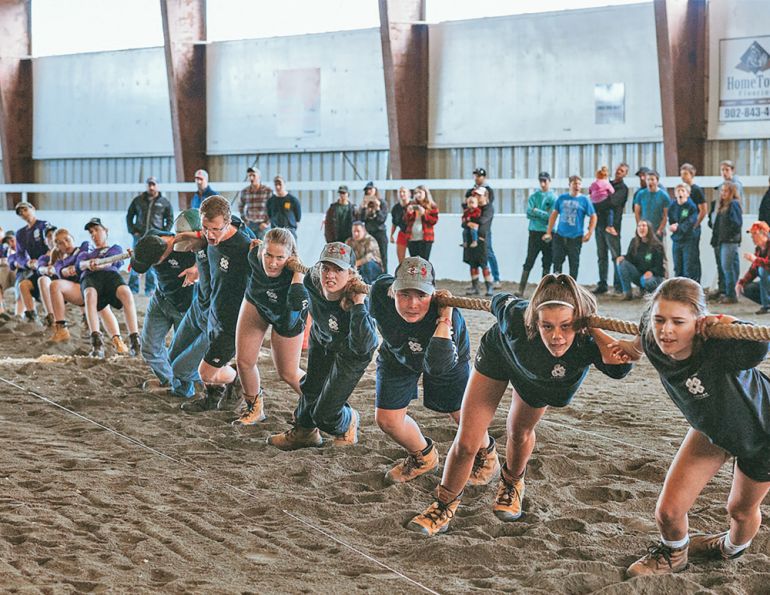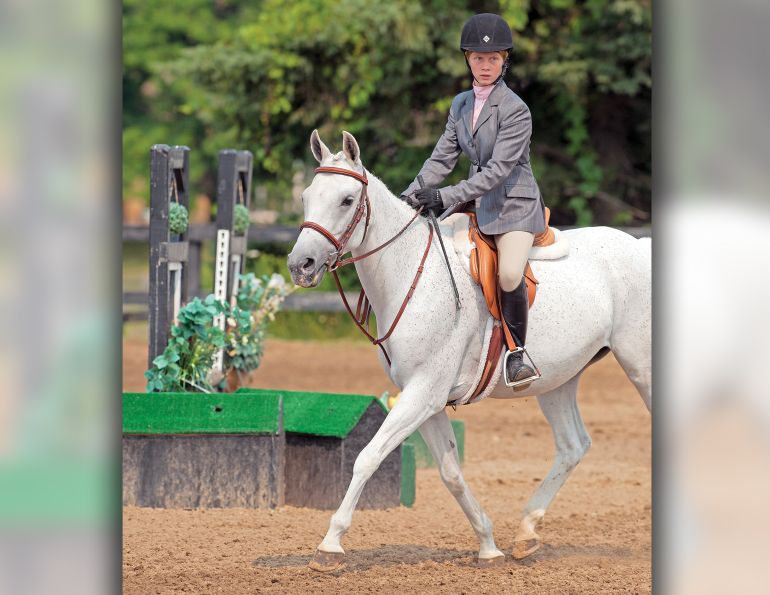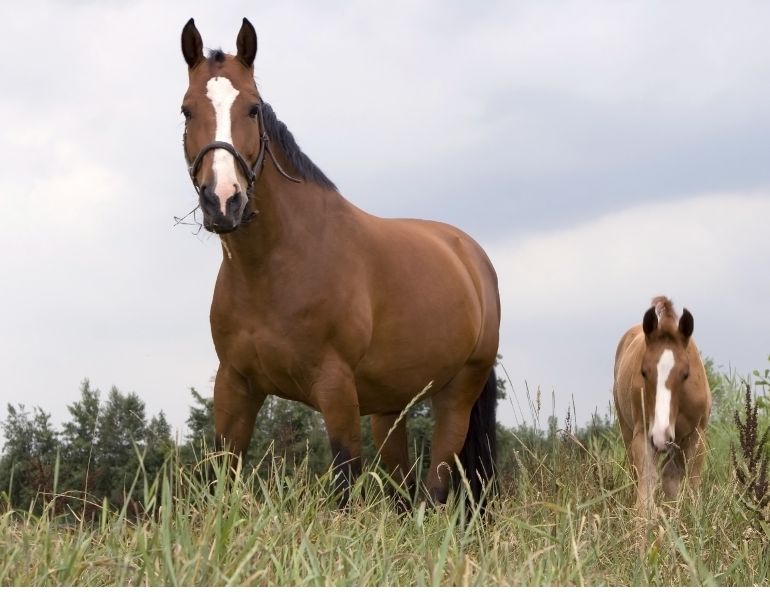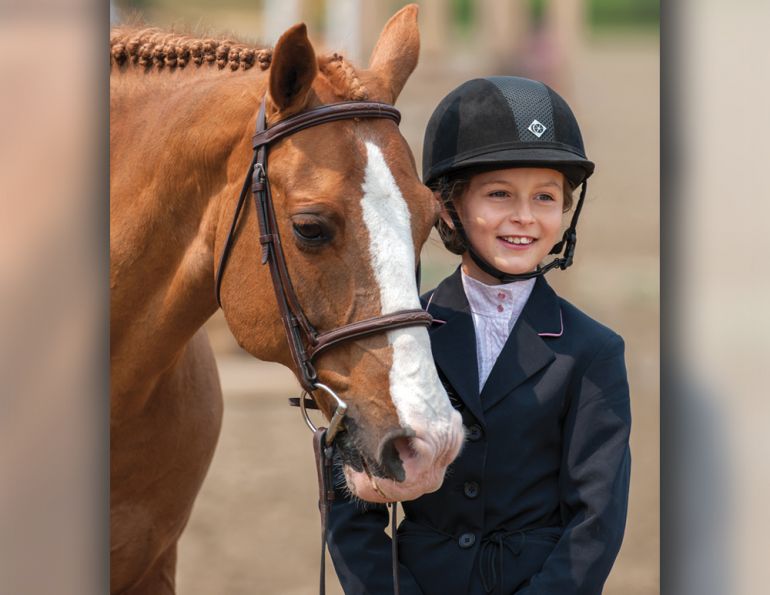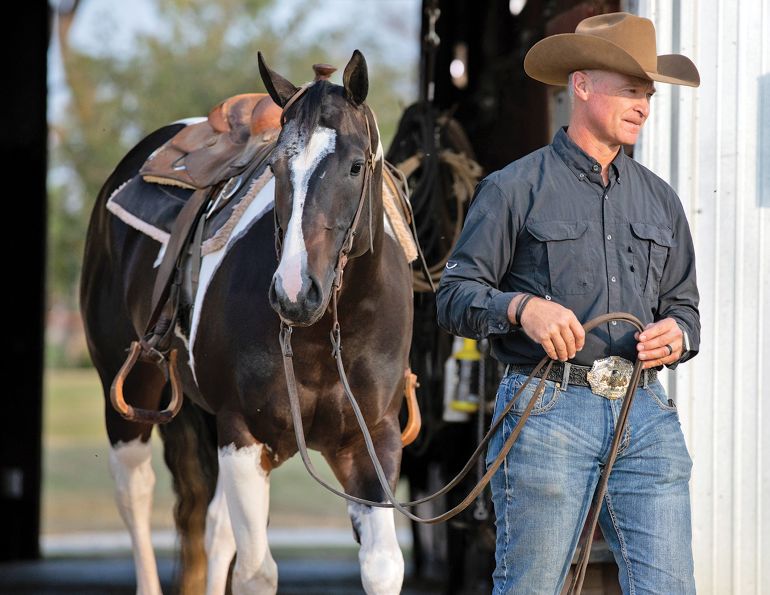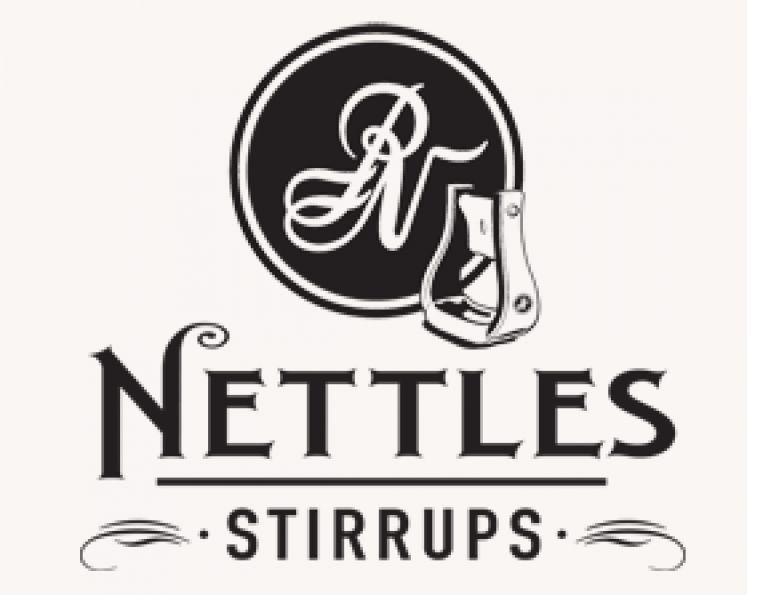Working and Playing Together
By Tania Millen, BSc, MJ
Operating family farms and ranches can be challenging, but according to these three Canadian families, there are plenty of benefits, too.
Farming with Kids
Lauren Fraychineaud and her husband Dave Allan are first-generation farmers. They own and operate Kalum Acres in Terrace, British Columbia (BC), along with their four children: Flint (5), Cea (4), Esme (2), and Eily (10 months). They bought the farm to raise their own food.
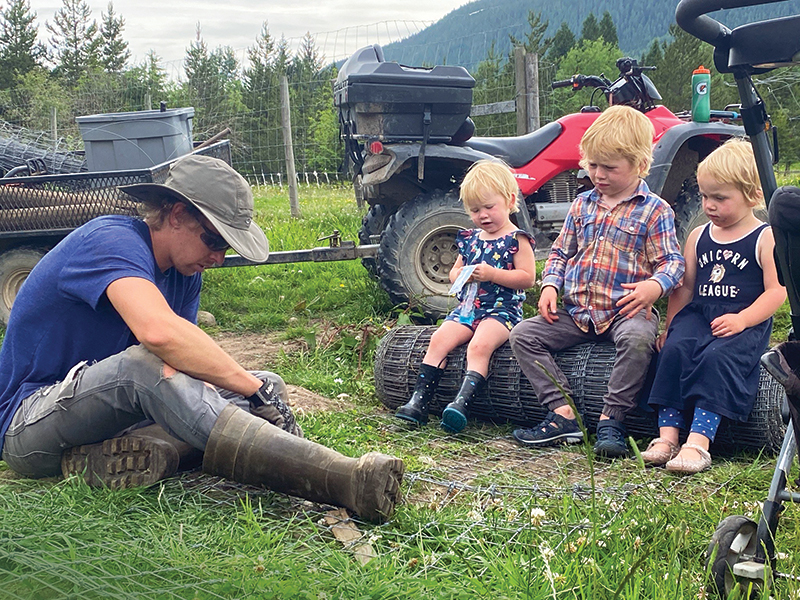
At Kalum Acres in Terrace, BC, the children help as much as they can. Esme, Flint, and Cea watch their Dad fix a fence. Photo courtesy of Lauren Fraychineaud
“Our kids help in every way they can, from collecting eggs and pushing around the kid-size wheelbarrow, to picking poop and feeding animals,” Fraychineaud says. She admits, “It takes a lot longer to do chores with our kids than it does without them. But it’s important to appreciate the help they’re providing. By taking on chores and being appreciated by us, the kids develop a sense of responsibility and achievement and sense of worth.”
“Our kids know that before we can do anything in the day, we’ve got to check on our animals. We spend a lot of time on the farm doing chores, so our family time looks different than movie nights and going on walks in town. Family needs and farm needs are very blended,” she says. “There’s a level of resilience that our kids get from farming that I don’t think the average kid gets. I think it’s rare that most kids, especially young kids, are uncomfortable. There’s a lot of discomfort that comes with the good things in life and I think it’s important to learn to embrace that discomfort.”
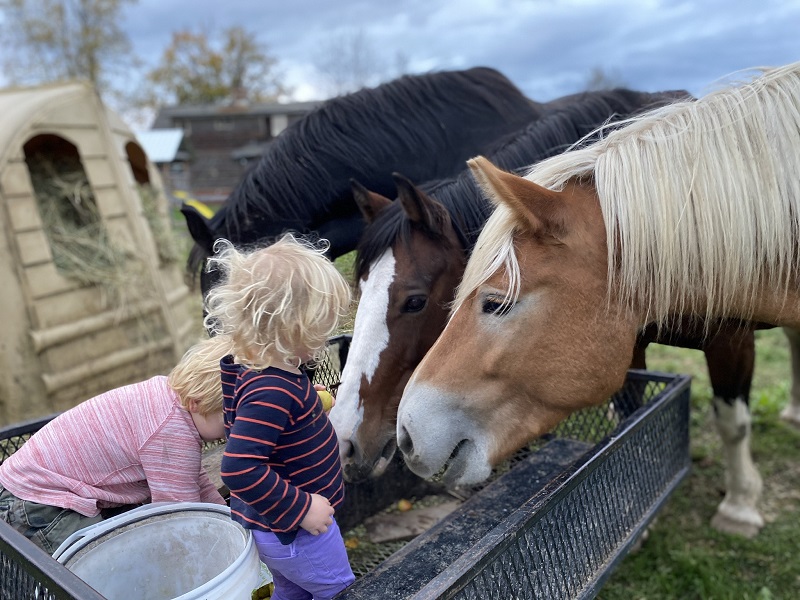
The Fraychineaud children feed the horses crab apples. Photo courtesy of Lauren Fraychineaud
But keeping small children safe while farming can be challenging. Animals, machinery, and standing water are all potential concerns.
“There’s a lot of added work making sure that we know where our kids are, and that they’re in a safe place. We communicate with our kids a lot. I think in general they are more mature and communicative than your average toddler and that’s because the consequences are high and they’re aware of that,” she explains. “It’s mentally and physically challenging to manage.”
Fraychineaud and Allan raise chickens, lambs, and pigs for meat, have five horses, plus both work as full-time college instructors.
“We’re both concerned about where our meat comes from, how it’s raised, and the quality of life [the animals have]. We also wanted our kids to be aware of where their food comes from, and to participate in raising it,” she says. “We can guarantee our animals have a quality life, and farming allows our kids to spend a lot of time outside and acquire skills to raise animals, whether they choose to do that in the future or not. They’re very keen and I think they have a greater sense of self [by] being included in the daily tasks. I think farming teaches them compassion.”
Related: Horse Property for Sale
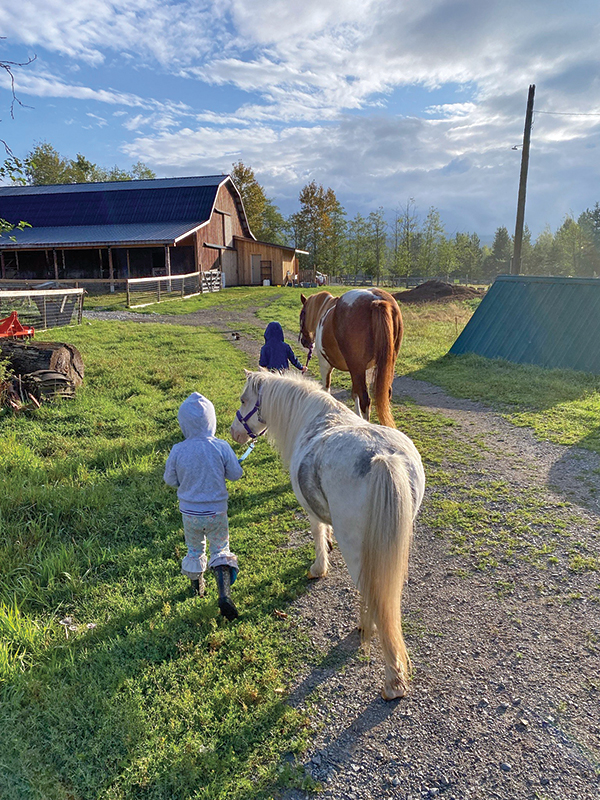
Above: Bringing in the horses at Kalum Acres. Below: Dave Allan, and Eily pet a friendly sow. Photos courtesy of Lauren Fraychineaud
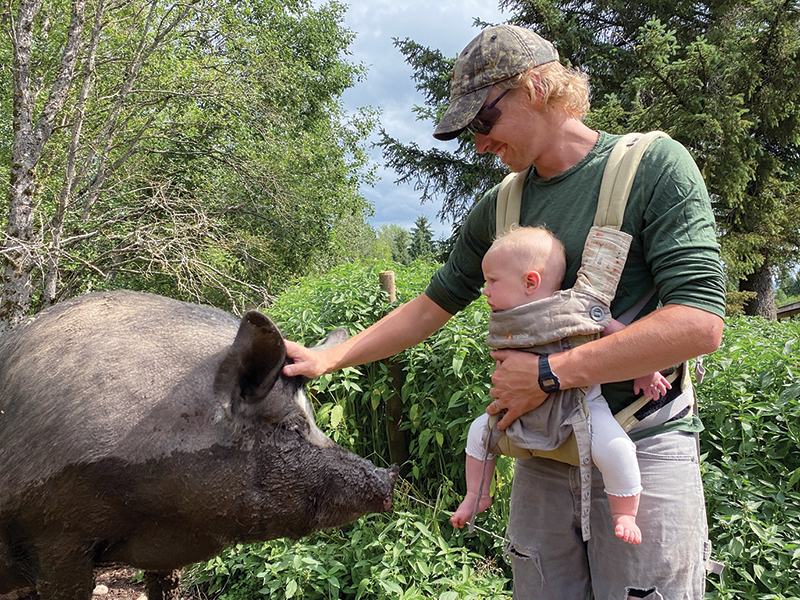
The Fraychineaud children also understand the life cycle.
“Our kids are aware of all the processes on our farm. We have a slaughter license. Our animals are born and slaughtered on our farm, which our kids participate in.
“Farming isn’t as glamorous as a lot of people think it is. Or maybe I’ve grown numb to the romance,” she jokes.
However, Fraychineaud feels fortunate to be able to farm with her family. “A lot of people come by who are envious that our kids get such a life. But a lot of them wouldn’t want to do the work or they wouldn’t want their kids participating in the work.
“I think our kids will thank us for it. Or maybe they’ll never come back!” she says.
Related: Living with Horses - A Place in the Country

Cea shows a piglet to little sister Esme. Photo courtesy of Lauren Fraychineaud
Multi-Generational Farming
Sandra Hessdorfer, her husband Chris, and their two boys Corbin and Riley, ages 13 and 12, operate a mixed grain and beef operation near Middle Lake, Saskatchewan. The farm has a long history.
“The operation started with my husband’s grandparents, then his parents, and now we farm the original land with Chris’ brother Laverne,” Hessdorfer says.
“I think growing up on a farm gives you character. Our kids are in 4-H and take care of beef cattle. They learned early on where babies come from and have witnessed cows giving birth. They understand where their food comes from and the love and work that goes into raising it. They’ve experienced the loss of a favourite animal and teaching them how to cope with that loss will hopefully make it easier for them to understand when loved ones leave us,” she says.

Quality family time is very important to the Hessdorfers who operate a mixed grain and beef farm that has been in the family for generations. ABOVE: In preparation for a show, Riley trims his 4-H steer. BELOW: “Our boys are learning what it means to take care of something, and that their needs and wants don’t always come first,” says Sandra Hessdorfer, pictured with a bottle-fed calf. Photos courtesy of Sandra Hessdorfer
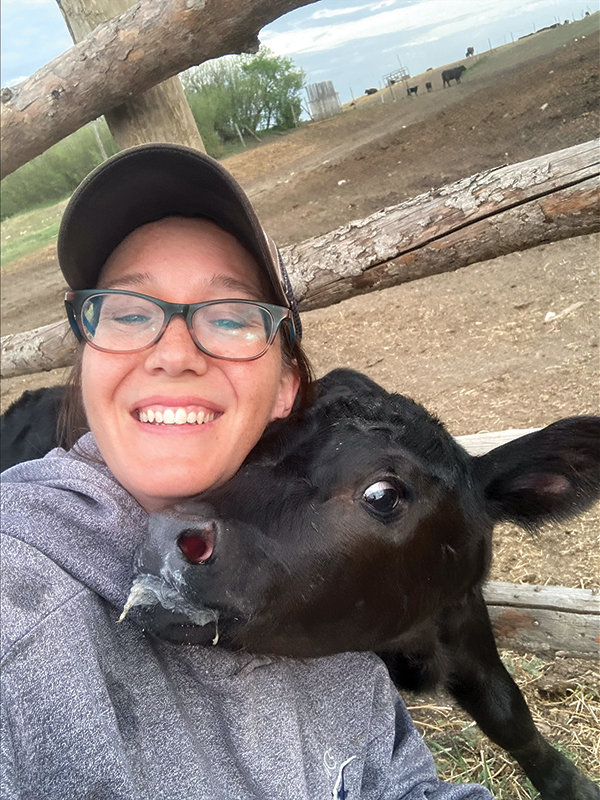
Chris and Laverne do the majority of the farming, while Sandra and the two boys primarily work with the cattle. Chris’s mum Theresa “helps with meals and has been an inspiration and confidante.”
There are both hardships and rewards in doing what you love but this is the life we chose,” she explains. “After building up our herd over the last ten years, we’ve had to downsize it due to the price of feed and dry conditions.”
However, Hessdorfer feels the benefits of farming outweigh the difficulties.
“We don’t get away much because of the cattle. But we all work together and our boys are learning what it means to take care of something, and that their needs and wants don’t always come first. We laugh a lot, even when things go wrong like when the cows get out. But we have a sense of accomplishment and pride when a calf is born or a crop hits the bins,” she says.
“It’s not easy and the weather can make you cry. But the sunsets, sunrises, and all the other little moments that you see because you’re in the field or out checking cows are amazing if you take the time to see them.”
Related: Continuing the Bridle Horse Tradition
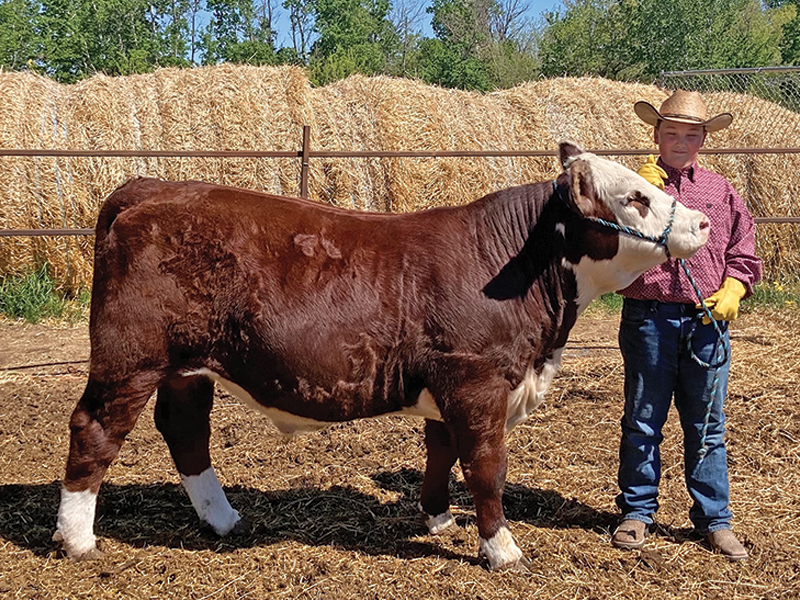
Corbin practices for a 4-H show. Photo courtesy of Sandra Hessdorfer
Hessdorfer thinks quality family time is of utmost importance to make up for days when the family takes a back seat to farming.
“Sometimes the most fun we have is fixing fences and picking rocks as a family. I married into this farm and I think anyone coming into a situation like this needs to realize how important this farm is to their spouse and the previous generations.”
But the future can be uncertain.
“One bad year can make you rethink your whole future. But we keep moving forward. We’re hoping our kids choose careers off the farm so they have a more stable way of life,” she says. “But we keep farming in case either of them wants to farm when they grow up.”
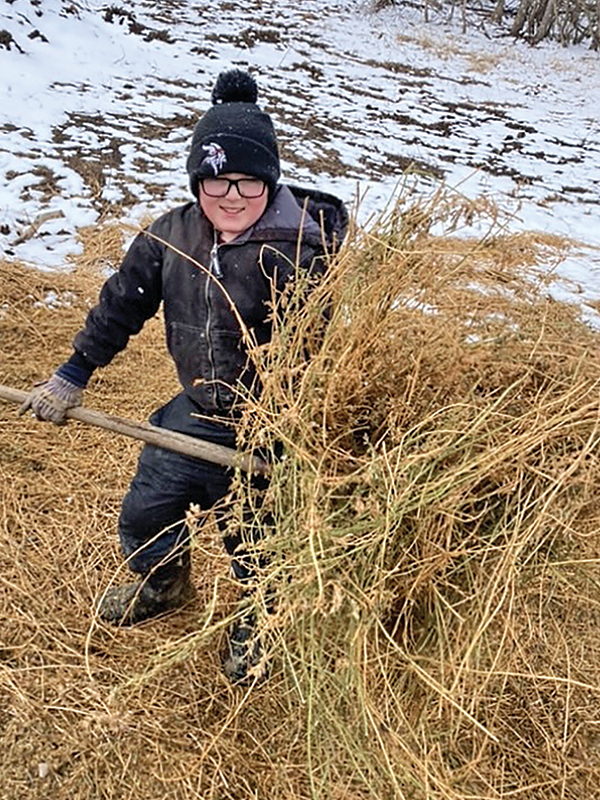
Riley feeds hay to his 4-H steers. Photo courtesy of Sandra Hessdorfer
Mixing Cattle and Horses
Menard Bird, his wife Shawna Blades-Bird, and 20-something kids Logan and Lakota, operate Lazy B Timed Event Horses and Cattle, near Nanton, Alberta. They supply cattle to about 50 rodeos a year including the Calgary Stampede, plus raise, train, and compete horses in timed rodeo events such as calf roping, team roping, and breakaway.
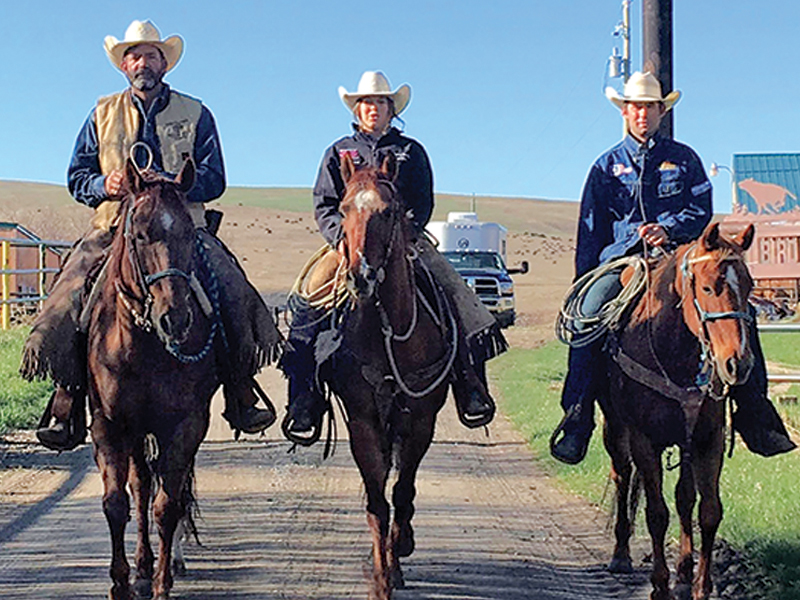
The Bird family operates Lazy B Timed Event Horses and Cattle near Nanton, Alberta. L-R: Manerd Bird, Lakota Bird, Logan Bird. Photo courtesy of Manerd Bird.
Logan and Lakota started competing at high school rodeos in about sixth grade and their enthusiasm spurred the horse side of the business.
“Fifteen years ago, we started training more and more horses. I started doing four or five horses a year. Now, we train about 30 head of horses a year, mostly for calf or open team roping, and breakaway,” Bird says. “That entails getting them ready and training them at rodeos. Then we sell them.”
Bird says that competing at high school rodeos was great for his kids and family.
“High school rodeo teaches so many things. Responsibility. Sportsmanship. How to take care of animals. The harder you work, the better you get and the more you get out of it.”
Those lessons have paid off.
Bird’s son Logan is a Canadian champion calf roper, and his daughter Lakota is a season leader in breakaway roping. Producing, showing, and selling top-quality rope horses is what they do.
“We’ve had three horses at the National Finals Rodeo (NFR) in Las Vegas, and we have lots of other good horses out in the rodeo world. We had a rope horse at the NFR last year,” he says.
Related: The 21st Century Cowboy
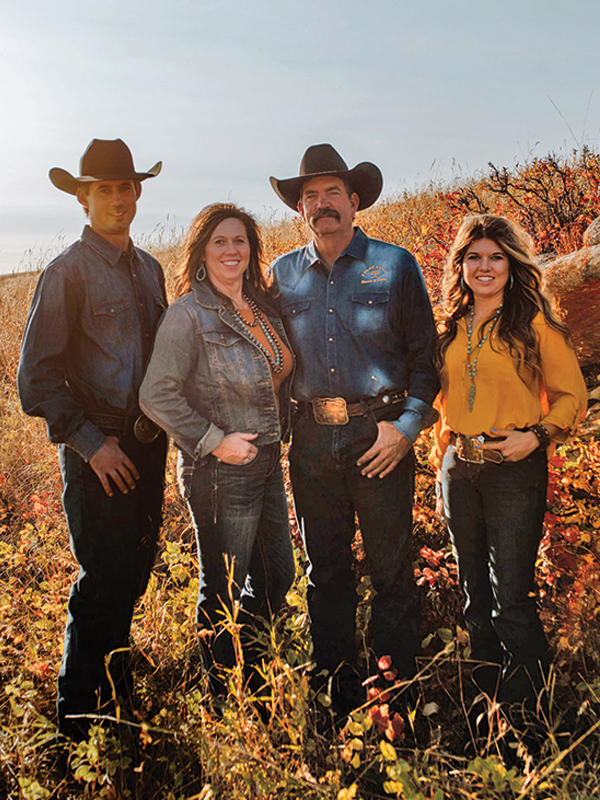
Above/Below: About 30 horses are trained by the Bird family each year for timed rodeo events such as calf roping, team roping, and breakaway. You’ve got to love it when your whole family can work and play together, says Manerd Bird. Photos courtesy of Manerd Bird
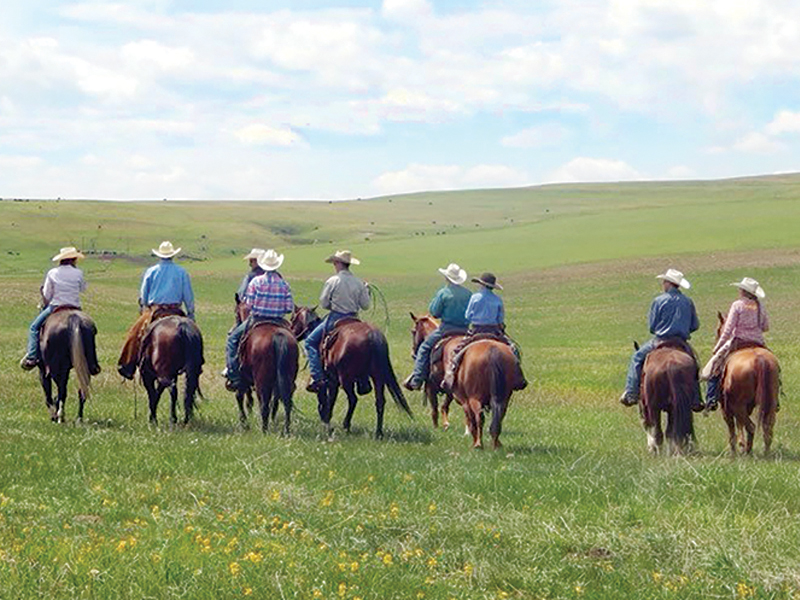
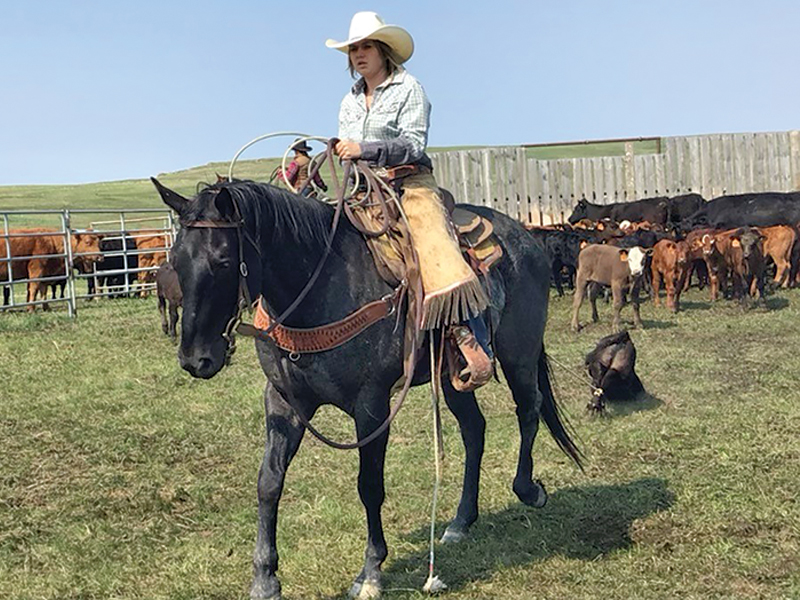
Another horse, T.J., earned over a million dollars for his riders. He was a grey gelding that excelled at tiedown roping, and was instrumental in the careers of several rodeo riders before he passed away unexpectedly in November 2021 at age 18. Logan just built himself a new house on the ranch, which he considers “The house that TJ built” because the horse’s earnings paid for the house.
When interviewed for this article, Bird and his family were in Arizona training horses for the winter.
“It’s great to be able to work with your kids. I really enjoy it,” he says. “The kids kind of run with it. They both learned how to train horses from me, so I can leave them and know the horses are going to get trained how I want. That’s my control freak side,” he jokes.
“We ride all day long, every day, in Arizona. We start in the morning and we don’t quit till dark. We believe in teaching the horse to work out of knowledge, not from being scared. We train our horses on our cattle after the cattle are done working the rodeos,” he explains.
“Every year we revisit what we’ve done as a family, then decide how many horses we’re going to produce — who’s going to be where and how many rodeos we’re going to do. And every year we tweak the program a little bit to make it better.”
But the last few years have been different.
“COVID has been a big challenge because two years ago they canceled all the rodeos. So, we had 500 head of rodeo-ready cattle that had nowhere to go. That was a pretty big challenge for our business,” he explains. “However, the horse market has done nothing but go up. The horse market is hotter than it’s ever been.
“The cattle and the horses go hand-in-hand. People see Logan and Lakota riding our horses at the rodeos and want to buy them. But it seems harder to find young horses if you don’t raise them yourself.
“The $100,000 to $200,000 horse is not unusual in our business now. There are lots of $50,000 ones. The days of buying cheap finished rope horses are over,” he says. “Who knows what’s going to happen down the road. But for now, horse prices aren’t going anywhere.
“During COVID, a lot of families were unsure whether their kids were going to be able to play baseball or hockey. Plus traveling for family vacations was difficult. But they could still rodeo and go roping as a family. So now the whole family has a horse, and they go and ride together and rope together on weekends,” he says. “I see this way more now than I’ve ever seen it before.”
Whatever the future brings, Bird says there will always be day-to-day good times with family.
“There’s nothing harder than being a farmer or rancher. It’s a lot of hours and a ton of work for little pay. But you’ve got to love it when your whole family can work together, play together, and enjoy. There are very few things that the whole family can do together for generations.”
Family farming and ranching are two of them.
Related: Parenting for Horse Professionals
Related: 4-H Canada - Learn to do by doing
Lauren Fraychineaud, who operates Kalum Acres with her husband and family in Terrace, BC drives a tractor with baby Eily. Photo courtesy of Lauren Fraychinead



